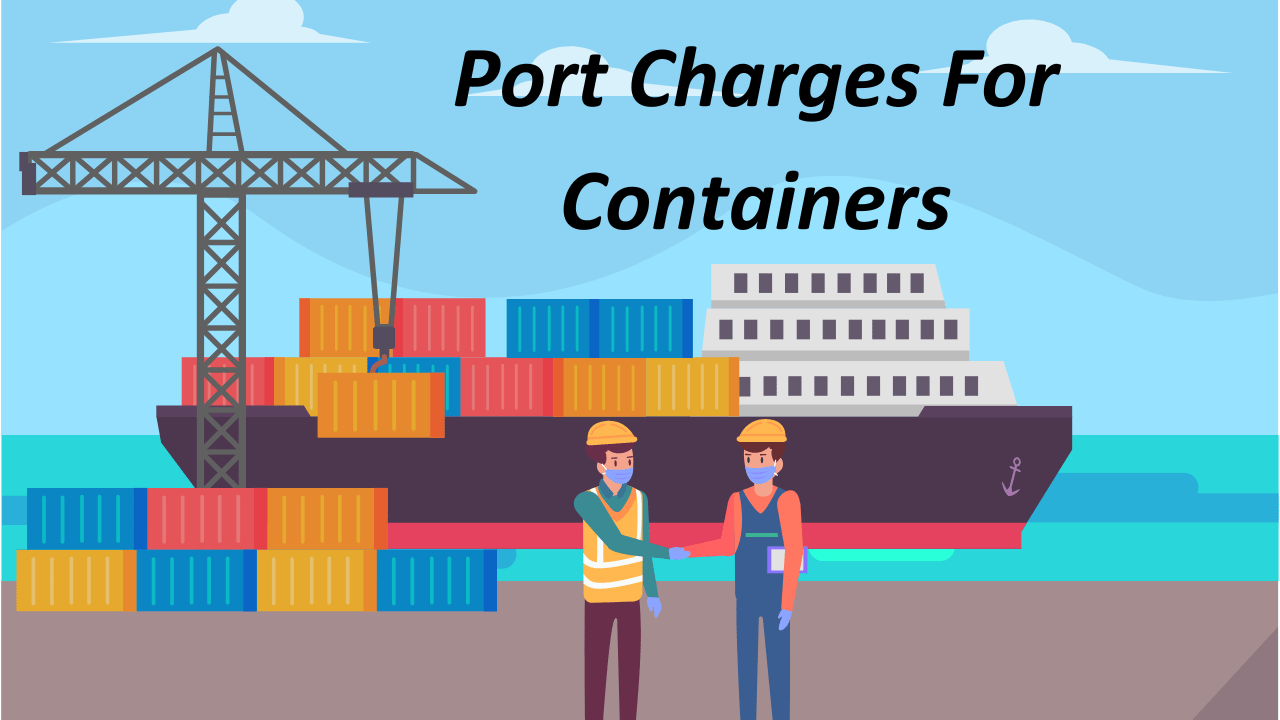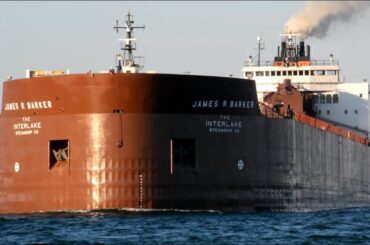Are you looking for a comprehensive guide to port charges for containers? You’ve come to the right place. As an experienced port charges and container shipping expert, I’m here to help give you all the information you need on this important topic.
Port charges are fees that must be paid when sending or receiving cargo via sea freight in containers. Whether it’s full container loads (FCL) or less than container loads (LCL), understanding these costs is essential if you’re involved with international trade.
By reading through this article, you’ll have everything you need to know about port charges – from determining which ones apply, to how they can affect your budgeting and bottom line. Let’s dive deeper into the world of ports and containers!
Definition
Let’s start with the basics. What is a container? A container is basically a big, rectangular steel box. Generally they’re 20 feet or 40 feet in length and can be used to store and transport cargo between different locations by ship, train or truck. The term “container” covers a wide range of containers including boxes, tanks, bins, hoppers and trailers.
Now that we’ve established what a container is, let’s look at how port charges apply to them. Essentially, port charges are fees incurred when using ports for loading or unloading goods. They vary depending on the type of vessel being used as well as which country it will traverse through before arriving at its destination. Some common types of port charges include harbor dues (for entering/exiting the port), pilotage fees (for navigating ships in hazardous waters) and customs clearance costs (for clearing items for import/export).
It’s important to note that these costs need to be factored into any shipment budget if you intend to move your goods via waterway transportation – whether it’s across international borders or just within one nation’s boundaries. Whether you’re an experienced importer-exporter or new to shipping containers, understanding the terminology associated with this industry is key to making informed decisions about your shipments.
Factors Affecting Container Charges
When it comes to port charges for containers, there are a number of factors that play an important role in determining the cost. Location is key when it comes to costs associated with container shipping; tariffs and taxes vary greatly depending on which port you’re using. Size also matters: larger containers tend to have higher rates compared to smaller ones. Seasonal fluctuations can significantly impact both availability and cost – some ports may be more expensive during peak season due to increased demand. Security measures must also be taken into consideration, as inspections and surcharges can add up quickly if not accounted for from the beginning. Finally, insurance should always be considered since accidents or damages incur additional fees.
Taking all these aspects into account will help ensure that your cargo arrives safely and at a reasonable price point. It’s essential to do your research when looking for reliable options, as different carriers offer various services tailored to different needs. Making sure you get the best deal possible requires thorough comparison shopping between companies before making any commitments.
Types Of Charges For Containers
When it comes to port charges for containers, there are several types of fees that will be assessed. Container-handling is one of the most common costs associated with shipping cargo by sea. This charge typically covers the cost of loading and unloading a container onto or from a ship along with other related services. Quay-rental fees cover the time spent in port when vessels drop off or pick up cargo or passengers. Container insurance is also required if goods are being shipped internationally; this fee helps protect against losses due to theft, damage, customs delays, etc. Additionally, peak surcharges may apply during certain times of the year – these additional fees help offset increased operational costs incurred at ports during high traffic periods. Finally, third-party services such as freight forwarding could incur their own set of charges depending on what type of assistance is needed.
In summary, there are various types of costs associated with container shipping that must be taken into consideration before embarking on an overseas voyage. It’s important to understand all applicable charges so you can budget accordingly and ensure your shipment reaches its destination safely and quickly.
Location-Based Charges
Location-based charges vary from port to port, and are determined by regional regulations. It’s important to be aware of the standard surcharge rates in each area before arranging a shipment. Depending on the destination, there may also be additional taxes or fees imposed at the local level. Understanding these location-based charges is essential for keeping your costs under control when shipping containers.
In some cases, you’ll need to pay more than just basic port fees; some ports charge an extra fee known as a congestion tax if they’re busy or overcrowded. This can add up quickly and significantly raise your overall container shipping expenses. Additionally, certain locations require that you obtain special permits or licenses prior to arrival – such failure to do so could result in hefty fines or other penalties.
It’s wise to research all relevant laws and regulations beforehand wherever possible, ensuring full compliance with any applicable rules and restrictions. Doing so will help protect against unexpected delays or added expenses which might otherwise arise due to noncompliance with port regulations. Taking proactive steps now helps guard against potentially costly issues later down the line – it’s worth investing time upfront for greater peace of mind!
Determining Container Size
In order to accurately calculate port charges, it is essential to know the size of a container. Container measurements and dimensions can be used to determine its size, as well as volume calculation which will help provide an accurate estimate for any associated fees.
The most common way of determining container size is by taking into account length, width, height, and weight measurements. All these factors must combine together in order to get a precise measurement of the container’s capacity. In addition, other details need to be taken into consideration such as internal supports or side doors on certain types of containers. It’s important that all elements are factored in when calculating the appropriate size so that you don’t pay extra due to incorrect estimates.
When shipping goods overseas via container there are several methods available for measuring and recording the size of your cargo including using templates or relying on digital technologies like laser scanners or 3D imaging technology. Each method has its own advantages depending on what type of cargo needs to be shipped and how quickly you need accurate measurements taken. No matter which route you take make sure you have properly accounted for every element involved before finalizing your calculations for port charges.
Container Shipping Costs
Container shipping costs can be tricky to figure out, as there are a number of variables that come into play. There’s the cost for the container itself, port fees and taxes, cargo costs, insurance and other related expenses. All these factors add up to determine the overall cost of shipment.
The cost of renting or purchasing a container is usually determined by size and type. Different ports may have different regulations when it comes to what kind of containers you’re allowed to ship from their facility. Prices also vary depending on the time of year, so make sure you check with your local port authority before booking anything.
When it comes to port charges and taxes, each country has its own rules regarding them. Be sure to do your research ahead of time to ensure that all applicable fees and taxes are accounted for in your estimated shipping cost. Additionally, some ports charge extra for services such as storage, loading/unloading and refrigeration—so factor those in too if needed. Lastly, don’t forget about additional cargo costs like fuel surcharges, documentation fees and more!
Knowing the full scope of potential costs associated with container shipping helps you plan better and budget accordingly—saving money in the long run. Do your due diligence upfront so you know what you’re getting into before signing any contracts or making payments on shipments.
Handling Fees
Once you understand the costs associated with container shipping, it’s time to look at handling fees. Container handling fees are usually determined by port authorities and include cargo handling fees, port service fees, or port handling charges. These charges cover everything from loading and unloading containers onto ships to managing storage in ports.
In addition to the basic fee for a ship to enter and leave a port, there may be additional port charges depending on the type of vessel being used. For example, a bulk carrier is charged differently than an oil tanker as they have different needs in terms of navigational requirements when entering and leaving port. Additionally, other factors such as size of crew may also have an impact on these handling charge fees.
Overall, understanding how much your company will need to pay for each shipment can help you plan ahead before committing resources to any given voyage. By taking into account all the relevant information regarding port charges, you can ensure that your shipments arrive at their destination safely — without having to worry about unexpected costs along the way.
Documentation And Miscellaneous Fees
Documentation and Miscellaneous Fees are often overlooked when considering port charges for containers. These fees can vary greatly based on the type of shipment, as well as its origin and destination ports. To help you understand these costs better, let’s look at a list of common documentation and miscellaneous fees:
| Cost Type | Definition | Fee |
|---|---|---|
| Customs Fee | Duty paid by importers to customs authority | Variable |
| Invoice Fee | Costs related to issuing invoices | $50 – $100 |
| Filing Fee | Charges for filing documents | Varies |
| Storage Fee | Any storage-related cost incurred | Variable |
| Demurrage Fee | Time-based fee charged after free time period expires |
These are just some of the most common additional port charges that may be added onto your total container shipping bill. In addition to these documented fees, there could also be other unexpected charges such as terminal handling fees or surcharges depending on where your cargo is being shipped from and/or delivered to. It’s important to keep in mind all possible costs associated with your particular shipment so that you don’t end up surprised with an unexpectedly large bill at the end of it all. Understanding how these charges apply to each individual shipment will ensure smooth sailing every step of the way.
Peak Season Surcharge
A Peak Season Surcharge (PSS) is a fee charged to container shipping companies during high demand periods. This additional cost can range anywhere from 5%-20% of the base tariff rate, depending on the port and carrier involved. It’s important for shippers to understand that this fee isn’t applied evenly across all ports or carriers; PSS rates vary significantly between different locations and operators, so it pays to do your research before committing to any agreement.
The purpose of a peak season surcharge is to adjust tariffs in response to seasonal spikes in demand. These fees are typically implemented when cargo volumes increase beyond what normal capacity allows. As such, they help ensure that port operators remain profitable even while handling larger-than-normal amounts of traffic. Without these adjustments, operations could become unsustainable due to overcrowding—so it’s essential for businesses who rely on international shipping services to factor them into their budgeting process.
It’s also worth noting that some shippers may be eligible for discounts or waivers if they sign long-term contracts with specific ports or carriers. While peak season surcharges can be costly and disruptive, understanding how they work and negotiating accordingly will ultimately prove beneficial in the long run. Carefully researching current rates ahead of time and staying up-to-date on any changes will help you make informed decisions about which routes offer the best value for money.
Quay Rent And Berth Usage Charges
Quay rent and berth usage charges are two of the most common port fees that container ports assess. Quay rent is a fee for utilizing an area within the port to store containers, while berth usage charges are associated with taking up dock space in order to unload or load cargo from vessels. Container ports typically have their own set of tariffs when it comes to quay rent and berth usage which must be followed by all users of the port.
When calculating these costs, shipping companies must take into account factors such as vessel size, time spent at the port and other services requested. As a result, there can often be large variations between different operators’ invoices when it comes to container port charges. It’s important therefore for companies to check what they’re being charged before committing to any agreement.
Due to increasing congestion levels, many ports around the world now have strict regulations on how long ships can remain docked without paying additional fees. This means that shippers need to factor in potential delays due to queues and busy periods when planning their routes and assessing overall cost implications. By having an understanding of their particular situation beforehand, shippers can ensure they make informed decisions about where best route their goods for maximum efficiency and profitability.
Security Costs For Containers
Security costs for containers are an important part of the overall cost of container shipping. These fees typically cover security measures that have been implemented at ports and on ships to protect against theft, terrorism and other risks associated with international trade. Security costs can include port security charges, container security fees and any additional security measures taken by authorities or private companies.
When looking into the specific details of these costs, it’s important to consider a few factors: What type of security is being provided? Are there any additional fees associated with securing your shipment? Is the level of security adequate for the cargo you’re transporting? And what sort of liability will be assumed if something goes wrong during transit?
The answers to these questions depend largely on the port facility and its regulations, as well as the individual carrier’s policies. In most cases, carriers must adhere to both local laws and industry standards when it comes to providing secure transportation services. It’s also important to understand that some ports may require more stringent levels of security than others – so knowing exactly which requirements apply in each case is key.
Knowing how much you’ll need to pay for port fees and container security can help you better plan ahead for your next container shipment – ensuring a smooth process from start to finish.
Insurance On Containers
Insuring containers and their cargo is a critical step in the shipping process. Without adequate insurance coverage, businesses stand to lose significant amounts of money if something goes wrong during transit. It’s important to understand what types of container insurance are available and how they’re priced so that you can make an informed decision when selecting the right policy for your needs.
Container insurance policies vary depending on several factors, including the type of goods being shipped, the origin and destination ports, as well as any additional services required such as storage or handling. Most policies provide protection against physical loss or damage due to external causes like fire, collision with other vessels, stormy weather conditions, and theft. Additional coverages may also be included such as delay in delivery time or liability for third-party claims resulting from a shipment incident.
The cost of insuring containers varies widely based on these factors but typically ranges between 1% and 5% of declared value per year. Insurance premiums are often paid upfront at the beginning of each shipping season, however some carriers offer discounts for those who pay annually in advance rather than one month at a time. Additionally there may be additional fees associated with obtaining certain kinds of coverage which should always be taken into account when calculating total costs.
It’s essential to take out sufficient insurance before sending off any shipments – not doing so could prove disastrous both financially and reputationally! Carefully research different policies available until you find one that offers comprehensive coverage at an affordable rate – this will ensure peace of mind throughout every stage of the shipping process.
Third-Party Services To Reduce Port Charges
Third-party services are becoming increasingly popular among container shipping operations looking to reduce port charges. These third-party providers offer a variety of services that can help significantly reduce the cost of freight forwarding and other related costs associated with containers.
| Service | Description | Benefits |
|---|---|---|
| Logistics Providers | Offers comprehensive logistics solutions for import/export cargo, including customs clearance, warehousing & distribution, inland transportation, etc. | Streamlines processes, reduces overhead costs and facilitates faster delivery times. |
| Freight Forwarding Services | Provides end-to-end support by coordinating shipment details between origin & destination points while arranging necessary documents like bills of lading or manifests. | Minimizes delays due to paperwork errors, simplifies compliance requirements and lowers overall expenses. |
These third-party service providers enable companies to achieve efficiencies in their shipping operations while also reducing the total cost of ownership (TCO). This is because they provide access to competitive rates on ocean freight and airfreight bookings as well as additional value such as tracking visibility and real-time information about the status of shipments throughout the entire process. Furthermore, these providers often have global networks which make it easier for shippers to compare different routes and carriers when selecting an optimal route for their container shipments.
In short, leveraging third-party services from specialized logistics providers offers many advantages which could ultimately result in significant savings on your company’s container costs. With careful consideration given to all aspects of the supply chain – from sourcing materials at origin through delivering goods at destination – you can ensure that your operation remains efficient and cost effective.
Best Practices For Minimizing Port Charges
When it comes to minimizing port charges for container shipping, there are several best practices that can help reduce costs. To begin with, shippers should be aware of the fees associated with each port and modify their routes accordingly. For example, if certain ports have higher taxes, they may wish to consider rerouting to a different port where the taxes are lower.
Another way to minimize port charges is by taking advantage of discounts. Many ports offer discounted rates depending on the number of containers being shipped or based on specific types of cargo. It’s important for shippers to research which ports provide these discounts in order to make sure they’re getting the lowest possible rate. Furthermore, when negotiating freight contracts, shippers should inquire about any additional discounts that could be applied.
Finally, shippers must also keep track of all paperwork related to their shipments such as invoices and customs documents so that nothing gets overlooked and unnecessary fees don’t go unnoticed. By staying up-to-date on documentation requirements and taking advantage of cost reduction opportunities wherever available, shippers can significantly reduce their overall port charges for container shipping.
Potential Tax Incentives
Potential tax incentives can provide cost savings for companies shipping containers through ports. Tax relief programs are designed to encourage economic growth, and many governments offer incentive programs or other types of financial assistance to businesses operating in their jurisdiction.
The most common type of incentive program is a container tax exemption or reduction. This may involve reducing the amount of taxes paid on imported shipments, or waiving certain fees associated with container transport. In addition, some government agencies may offer additional benefits such as lower port charges or reduced customs duties. It’s important that companies research all available options before making any decisions about port charges and potential tax incentives.
| Tax Incentives | Potential Benefits |
|---|---|
| Container Taxes | Reduced/Waived Fees |
| Port Taxes | Lower Port Charges |
| Customs Duties | Reduced Customs Duties |
Incentive programs vary greatly between countries and regions, so it’s important to investigate what is available in each specific area prior to taking advantage of any offered tax breaks or incentives. Companies should also be aware of any applicable laws governing these arrangements and ensure compliance with them when seeking out potential cost savings from taxes or other forms of financial assistance related to container transport.
Conclusion
As a port charges and container shipping expert, I can confidently say that understanding the various components of these costs is an essential part of successful operations. Knowing how to calculate, minimize and manage them will help you keep your business competitive while still providing customers with reliable services.
It’s also important to consider potential tax incentives when determining port charges for containers. By carefully researching and taking advantage of any applicable credits or deductions, you could end up saving significantly on freight costs over time.
Overall, there are many factors to take into account when managing port charges for containers. With the right knowledge and strategies in place, however, it is possible to reduce operational expenses without sacrificing quality service.







